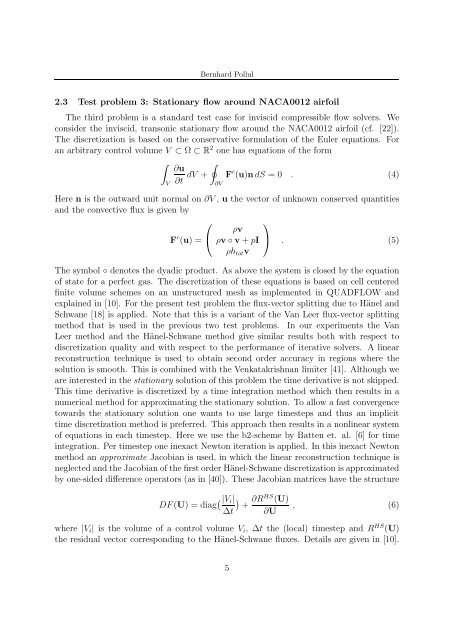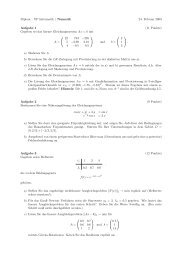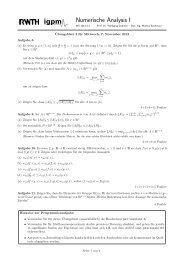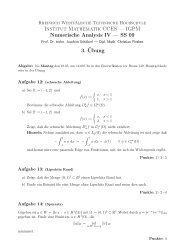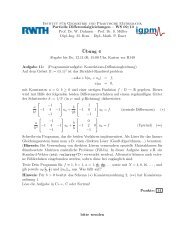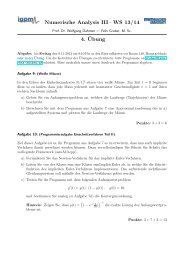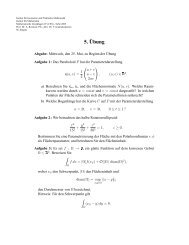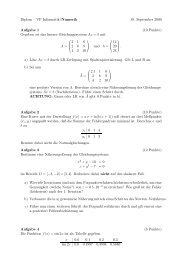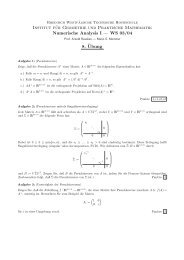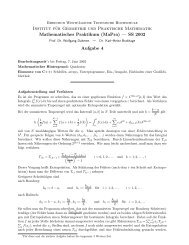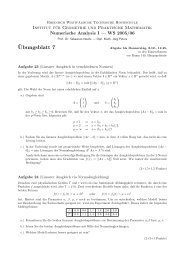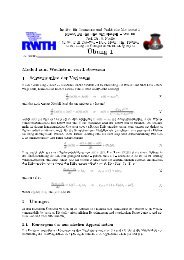preconditioners for linearized discrete compressible euler equations
preconditioners for linearized discrete compressible euler equations
preconditioners for linearized discrete compressible euler equations
Create successful ePaper yourself
Turn your PDF publications into a flip-book with our unique Google optimized e-Paper software.
Bernhard Pollul<br />
2.3 Test problem 3: Stationary flow around NACA0012 airfoil<br />
The third problem is a standard test case <strong>for</strong> inviscid <strong>compressible</strong> flow solvers. We<br />
consider the inviscid, transonic stationary flow around the NACA0012 airfoil (cf. [22]).<br />
The discretization is based on the conservative <strong>for</strong>mulation of the Euler <strong>equations</strong>. For<br />
an arbitrary control volume V ⊂ Ω ⊂ R 2 one has <strong>equations</strong> of the <strong>for</strong>m<br />
∫<br />
∂u<br />
∂t<br />
∮∂V<br />
dV + F c (u)n dS = 0 . (4)<br />
V<br />
Here n is the outward unit normal on ∂V , u the vector of unknown conserved quantities<br />
and the convective flux is given by<br />
⎛<br />
ρv<br />
⎞<br />
F c (u) = ⎝ ρv ◦ v + pI ⎠ . (5)<br />
ρh tot v<br />
The symbol ◦ denotes the dyadic product. As above the system is closed by the equation<br />
of state <strong>for</strong> a perfect gas. The discretization of these <strong>equations</strong> is based on cell centered<br />
finite volume schemes on an unstructured mesh as implemented in QUADFLOW and<br />
explained in [10]. For the present test problem the flux-vector splitting due to Hänel and<br />
Schwane [18] is applied. Note that this is a variant of the Van Leer flux-vector splitting<br />
method that is used in the previous two test problems. In our experiments the Van<br />
Leer method and the Hänel-Schwane method give similar results both with respect to<br />
discretization quality and with respect to the per<strong>for</strong>mance of iterative solvers. A linear<br />
reconstruction technique is used to obtain second order accuracy in regions where the<br />
solution is smooth. This is combined with the Venkatakrishnan limiter [41]. Although we<br />
are interested in the stationary solution of this problem the time derivative is not skipped.<br />
This time derivative is discretized by a time integration method which then results in a<br />
numerical method <strong>for</strong> approximating the stationary solution. To allow a fast convergence<br />
towards the stationary solution one wants to use large timesteps and thus an implicit<br />
time discretization method is preferred. This approach then results in a nonlinear system<br />
of <strong>equations</strong> in each timestep. Here we use the b2-scheme by Batten et. al. [6] <strong>for</strong> time<br />
integration. Per timestep one inexact Newton iteration is applied. In this inexact Newton<br />
method an approximate Jacobian is used, in which the linear reconstruction technique is<br />
neglected and the Jacobian of the first order Hänel-Schwane discretization is approximated<br />
by one-sided difference operators (as in [40]). These Jacobian matrices have the structure<br />
DF(U) = diag ( |V i | ) ∂R HS (U) +<br />
∆t ∂U<br />
, (6)<br />
where |V i | is the volume of a control volume V i , ∆t the (local) timestep and R HS (U)<br />
the residual vector corresponding to the Hänel-Schwane fluxes. Details are given in [10].<br />
5


